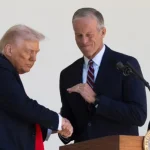
–>
April 14, 2023
Historians will have a hard time grappling with the enormity of the efforts by the media, the Department of Justice, and their allies in the intelligence community (IC) to stop Donald Trump. For a more manageable case study they would do well to look at the 2006 re-election campaign of then 10-term Pennsylvania Congressman Curt Weldon. Seventeen years later, Weldon has a lot to say—with more to come—about how this unholy cabal subverted the democracy its apparatchiks profess to champion.

Official House portrait of Rep. Curt Weldon
‘); googletag.cmd.push(function () { googletag.display(‘div-gpt-ad-1609268089992-0’); }); }
Weldon recently sent me a video tribute made on his behalf in spring 2007 by then former president George H.W. Bush. The occasion was the annual symposium and dinner for the National Fire and Emergency Services, an organization Weldon, a volunteer fire chief, had been leading for the previous twenty years. Without a hint of irony, Bush praised Weldon for a legacy that left the nation “stronger, better, and safer” and wished him well on the “new chapter” in his life. What Bush did not tell the 2,000 fire service workers was that his son’s DOJ, working closely with the media and IC, had just executed a coup on their leader that necessitated this “new chapter.”
The Bushes, father and son, were either quiet participants in the coup or too weak to resist. I suspect the latter. Two months before the fire services dinner, they watched mutely as Vice-President Dick Cheney’s Chief-of-Staff, Scooter Libby, was convicted of perjury and obstruction of justice. Many of the same agents that took out Weldon also took out Libby on charges that were as flimsy as those Manhattan D.A. Alvin Bragg has levied against Trump. Whatever his state of knowledge, George W. Bush never had control of a Justice Department staffed to the teeth with Democratic activists.
When I first met Weldon in July 2006, I had no clue about the forces aligned against him. Although a moderate Republican, Weldon had been impressively immoderate in his probe of deep state corruption. His 2005 book, Countdown to Terror: The Top-Secret Information that Could Prevent the Next Terrorist Attack on America—and How the CIA Has Ignored It, testified to his willingness to mix it up with Washington’s entrenched powers. In fact, Weldon left our meeting at his congressional office to review files on the Sandy Berger case.
‘); googletag.cmd.push(function () { googletag.display(‘div-gpt-ad-1609270365559-0’); }); }
The Berger case is the deep state’s Rosetta Stone, the key to deciphering its mysteries. In 2004, while reviewing files at the National Archives in preparation for the 9-11 Commission hearing, Berger, Bill Clinton’s national security advisor, stole highly classified documents, stored them under a construction trailer during a break, retrieved them at day’s end, admittedly cut them up, and threw the pieces away.
On April 1, 2005, the DOJ announced its extraordinary plea deal with Berger—a $10,000 fine and a three-year suspension of his top-level security clearance. Long before Trump’s emergence, Democrats were playing by a radically different set of rules. At least three of the DOJ attorneys mishandling the Berger case were Democrat donors. One of them, Howard Sklamberg, executed the hit on Weldon. Orchestrating that hit, incredibly enough, was none other than Berger himself.
Weldon was not an easy target. Although his suburban Philadelphia district skewed slightly Democrat, Weldon had been winning re-election by comfortable margins in both good and bad Republican years. Berger set out to change that. In March 2006, less than a year after his plea deal, he hosted a fundraiser for the newly minted Democrat designated to replace Weldon, Joe Sestak. A vice admiral who served on Bill Clinton’s national security council, Sestak had not lived in Weldon’s district for thirty years.
Berger also volunteered the Director of Communications at his firm, Stonebridge International, to serve as Sestak’s campaign spokesperson.
Contributing to that campaign were all the usual suspects: Tony Lake, Clinton’s national security advisor before Berger; Richard Clarke, Clinton’s anti-terror honcho; Mary O. McCarthy, fired from the CIA for allegedly leaking secret information about overseas prisons to the Washington Post; and John Deutch, the Central Intelligence Director pardoned on Clinton’s last day after agreeing to a plea deal for mishandling classified documents. Sestak was one of two congressional candidates Deutch donated to in 2006. The other four donors, Berger included, made their only federal contribution in 2006 to Sestak.
If the national media chose not to see, the local media understood the rationale for the support of Sestak by Berger and friends. “A Sestak victory,” reported the suburban Delco Times, “would muzzle a Republican congressman who blames Clinton for doing irreparable harm to America’s national security during the 1990s.”
‘); googletag.cmd.push(function () { googletag.display(‘div-gpt-ad-1609268078422-0’); }); } if (publir_show_ads) { document.write(“
Clinton was in on the game as well. In late September 2006 he submitted to an interview on FOX News with Chris Wallace. Unprompted, Clinton told Wallace, “A three-star admiral, who was on my National Security Council staff, who also fought terror, by the way, is running for the seat of Curt Weldon in Pennsylvania.”
Clinton did not mention Sestak by name. He may not have remembered it. Nor did he note that Sestak had been reduced to two-star rank, which likely accounted for his availability. Clinton used the interview to target Weldon, the only Republican mentioned in his interview other than President George W. Bush.
Despite Clinton’s support, Weldon held a 7-point lead heading down the home stretch. Then in mid-October, three weeks before the election, the conspirators got to work. The three-front attack began with a DOJ leak to the media, published widely on Friday, October 13. Readers were told that Weldon “traded his political influence for lucrative lobbying and consulting contracts for his daughter.”
“The article that was spoon fed to the scumbag Bloomberg reporter by two anonymous sources was full of deliberate lies,” Weldon tells me. “My daughter was never a lobbyist.” On Monday, October 16, the DOJ called in the FBI. Citing the need to act swiftly now that the news of the DOJ investigation had been leaked, the FBI “searched four homes and other locations in the vicinity of Philadelphia and two other sites near Jacksonville, Fla., as the part of the inquiry.”
The New York Times was reporting the above on the day it happened. By noon of that same day, Democratic operatives had assembled a group of 20 or so rank and file and had given them matching signs that read, “Caught Red-Handed.” Weldon claims to have evidence that the DOJ informed Sestak’s people three weeks before the raid, allowing them to adjust their ad buys and plan their response.
With the Bush family, it is hard to know whether they were conspirators or too compromised to push back, likely the latter. In any case, says Weldon, the George H.W. Bush tribute took place “just 5 months after Sklamberg conducted the raids on my daughter’s home and [he] NEVER talked to her – nothing! Attorney John Gallagher was issued a personal apology several days after they raided his office.”
The raid was never about justice. It was about optics. There was no need for the DOJ to follow up. Weldon had been bloodied. The mission had been accomplished. And on a Tuesday three weeks after the raid, the election had been “won.”
Jack Cashill’s newest book, Untenable: The True Story of White Ethnic Flight from America’s Cities, is available for pre-order in hard cover, ebook, and audio.
<!– if(page_width_onload <= 479) { document.write("
“); googletag.cmd.push(function() { googletag.display(‘div-gpt-ad-1345489840937-4’); }); } –> If you experience technical problems, please write to [email protected]
FOLLOW US ON
<!–
–>
<!– _qoptions={ qacct:”p-9bKF-NgTuSFM6″ }; ![]() –> <!—-> <!– var addthis_share = { email_template: “new_template” } –>
–> <!—-> <!– var addthis_share = { email_template: “new_template” } –>






